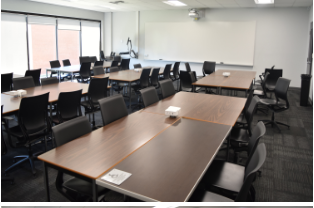Preparing to Teach While Wearing a Mask
Laura Stoutenburg and Kathryn Brillinger
During the last year and a half, hundreds of students have attended class at Conestoga, all of them and their teachers wearing masks. So far, there have been no significant complaints about their ability to hear and understand their professors because of face masks. Those of us going back into the classroom for the first time since 2020 can take heart – teaching with a mask can work!
As we get ready for our in-person classes, how can we prepare to teach so that everyone can hear and process what we say? This teaching tip gathers advice and suggestions from experts in hearing and education for some no-tech practices and some-tech-enabled practices to help ensure maximum clarity in the classroom.
Note: If you have a student with an accommodation for a hearing-related need, rest-assured, that if tied to an accommodation, see-through masks can be arranged through Accessible learning and your department.
No tech practices
Position yourself at the front and centre of the room: Move about less so students can focus on an audio stream coming from a predictable point. Your voice is also more constant if you are not moving. Of course, you can learn to move and project but most of us lack that rock-star experience.
Eliminate or minimize background noise: Avoid playing music or creating other background noise when you or others are speaking. Point out to students that it is important to take turns speaking and not to carry on side conversations while you or another student is speaking. You, too, should avoid interrupting/talking over others. If you have students work in small groups, seat them away from noise sources. (Oticon, 2020, Pourret et al., 2020; Wolfe et al, 2020)
Articulate clearly: Take time to articulate a little more clearly than you are used to. Say your words clearly and precisely, blend your words together less than you usually do, slow down somewhat, and pause between phrases and sentences, stressing key words. (Oticon, 2020; Pourret et al., 2020; Schafer et al., 2021). If you want to practice clear speech techniques, this resource describes simple exercises you can try.
Use gestures: Gestures are an integral part of how sighted humans communicate, and they play a central role in teaching and learning (Roth, 2001). Gestures add visual cues to enhance meaning. When facial expressions are largely hidden behind masks, now is the time to take advantage of gestures to enhance the messages you are conveying through words and pictures. You can point at key words or pictures, use gestures to show affirmation, make gestures to indicate height, length, or other measurable concepts, and use batonic (beat) hand gestures to emphasize key terms.
Avoid muffling behaviours: Don’t chew gum, avoid having things like lozenges in your mouth while talking, and make sure your face is turned toward your students while you are speaking. Don’t talk to the board, and don’t cover your face with your hand while you are speaking. (Schafer et al., 2021)
Establish the subject: Take care to let students know what you are talking about, especially when you change subjects. This makes speech easier to follow. (Oticon, 2020) See visual cue suggestions below for supports in establishing what the subject is.
Repeat and recast: Repeat important points and recast student contributions to ensure they were heard by everyone in the room. (Torres, 2021; Schafer et al., 2021)
Encourage strategic seating: Encourage anyone who is having trouble hearing you to sit closer to the front in full view of your face (Schafer et al., 2021) Always remember that “preferred seating” is on some accommodation forms and never force students to move to a particular seat or grouping. You can invite particular students to move into particular groups but if someone pushes back leave it and chat with them privately at another time.
Elicit feedback from your students. You can provide students with an opportunity at the end of the class to identify whether your communication strategies are working using a Start, Stop, Continue or other feedback opportunity. Wolfe et al. suggest creating signals for your students to use; develop a “silent” system for students to let you know they can’t hear/understand you. One educator developed a red card/green card system for class. If a student put the red card on top of the green card, it meant they were having trouble understanding. You can encourage a gesture such as ear tugging as a signal that you need to speak more clearly. (Wolfe et al, 2020; Pourret et al., 2020)
Face Mask Decisions
Once the College transitions to allowing personal face masks, consider what type of face mask you will wear.
Wear a mask that gives your mouth and lips freedom to move: You may have already found a mask that works for you. There are an increasing number of options, such as a singer’s mask or an added sports cage insert (Callahan, 2020; Abma, 2021).
Consider a transparent face mask: Note that there are pros and cons to transparent masks. “While transparent face masks may improve access to visual cues, they attenuate [make harder to hear] the speech signal to a greater degree than surgical masks…, and the addition of a face shield combined with a nontransparent or transparent face mask results in even greater attenuation” (Schafer et al., 2021, p. 889). In other words, what you gain in students being able to see your mouth move, you may lose in attenuated sound with these types of masks.
Tech support for clarity
Use clear visuals as cues. Using PPT or other supports, accompany your teaching with graphs, visuals and key words. This will help establish the subject (see above) and it will provide visual support for understanding the main teaching points. (Pourret et al., 2020). Consider listing a glossary or key terminology for the session on the board and keep referring back to the terms as PowerPoint slides change. Invite students to photograph the board at certain junctures so they maintain this visual memory aid.
Plan listening breaks: Plan opportunities for quiet processing in class, such as giving students time to answer a mentimeter poll, read from the text and prepare a response, or write a reflection. (Wolfe et al, 2020). It is easier to attend when the brain has rested a bit.
Consider amplification: A number of the experts in hearing and education recommend wearing a microphone to amplify sound. (Pourret et al., 2020; Schafer et al., 2021)
You can purchase a remote microphone in the $30 range if you wish to amplify your voice in the classroom. There will also be a limited number of microphones available to loan through the College library. If you follow all the tips above, a microphone may not be necessary in most classes. Having to hold a device can limit your ability to gesture, demonstrate, and use the board.
What about Teaching Pronunciation? Can this be done in a mask?
Are there some things that just can’t be done with a mask? What about teaching students how to pronounce words? The good news is that teachers across the world have continued to successfully teach pronunciation in-person with masks. Here are some of the tips pronunciation teachers have shared which may be useful to all faculty when language is a factor in the classroom.
Show the pronunciation. It is still important to show students what a particular sound or sound patterns looks like (McLoughlin 2020). Use Sammy diagrams of the mouth, arrows and beats on the whiteboard or PPT slide, or use short videos that you have found online or created.
Gestures: You have a wealth of gestures and props at your disposal. It is time to stretch rubber bands and tap on the desk again to show stress patterns. Hand gestures can trace intonation patterns in the air.
Repetition: Repetition and recasting of your own and the students’ words becomes even more important in the pronunciation classroom (Torres, 2021). You can repeat a tricky word or phrase seven times in a row. The repetition will help students focus on the aural cue and absorb the sound pattern before trying it themselves.
Practice and Share: have students practice and record themselves at home for homework (video or audio) (McLoughlin 2020).
Pair Homework: Assign pronunciation homework in “buddies,” having them use Zoom or other online visual platform (McLoughlin 2020).
Use Choral Repetition and Full Class Drills. You can still do choral drills. Bone conduction of sound internally and the togetherness of joint sound production can be both helpful and rejuvenating (CBC/Radio Canada, 2018). In fact, marketers are using this technique for sales yet teachers don’t always realize bone conduction can be used for learning (Halpin & Rowan, 2021)! The key here is to give students an opportunity to drill individually so that you can hear them (McLoughlin 2020).
Would you like to learn more?
Teaching and Learning will be holding workshops on Teaching In-Person: Setting Up the Room, Welcoming Students and Designing the First Class – (EDV0190). Why not sign up and joining a Teaching and Learning team for a refresher on key considerations for in-class teaching?
If you have questions or would like to make further suggestions for this tip, please contact us at teachingandlearning@conestogac.on.ca.
References
Abma, S. (2021). Soprano creates mask made specially for singers. Retrieved from https://www.cbc.ca/news/canada/ottawa/masks-singers-choirs-pandemic-1.6227475.
Callahan, C. (2020, September 3). This teacher went viral for discovering this face mask accessory. Today. Retrieved from https://www.today.com/shop/face-brackets-masks-t190588. McLoughlin, A. (2020, September 9). Teaching pronunciation – 5 tasks with masks. ELT Connect. Retrieved November 19, 2021, from https://elt-connect.com/teaching-pronunciation/ .
CBC/Radio Canada. (2018, March 29). The science behind why choir-singing is good for you | CBC radio. CBC news. https://www.cbc.ca/radio/blogs/the-science-behind-why-choir-singing-is-good-for-you-1.4594292.
Halpin, A., & Rowan, D. (2021, November 17). Getting brands into brains using bone conduction. The Conversation. https://theconversation.com/getting-brands-into-brains-using-bone-conduction-16015.
McLoughlin, A. (2020, September 9). Teaching pronunciation – 5 tasks with masks. ELT Connect. Retrieved November 19, 2021, from https://elt-connect.com/teaching-pronunciation/ .
Oticon. (2020). Communication is a two-way street: Better Communication Habits: A Guide for Family and Friends. https://wdh02.azureedge.net/-/media/oticon-us/main/download-center—myoticon—product-literature/consumer-library/15500-2068—communication-is-a-two-way-street—alliance-brochure—2020.pdf?la=en&rev=47F7&hash=B72BA434761B93DA3BDD8D66A4AE932D#:~:text=Communication%20is%20a%20two%20way%20street.&text=Communication%20is%20the%20key%20to,hearing%20loss%20can%20function%20today.
Pourret, O., & Saillet, E. (2020). Wear your mask, but think about deaf students. Nature, 586(7830), 629–630.
Roberts, M., Rowlands, L. M., Parker, K., Hepburn, H., Enser, M., Reynolds, E., Barton, G., Team, T. E., Martin, M., & Reporter, T. (2021, March 10). How to use body language to improve teaching in a mask. Tes. from https://www.tes.com/news/covid-schools-reopening-how-use-body-language-improve-teaching-mask.
Roth, W.-M. (2001). Gestures: Their role in teaching and learning. Review of Educational Research, 71(3), 365–392. https://doi.org/10.3102/00346543071003365
Schafer, E. C., Dunn, A., & Lavi, A. (2021). Educational Challenges During the Pandemic for Students Who Have Hearing Loss. Language, Speech, and Hearing Services in Schools, 52(3), 889–898. https://doi-org.conestoga.idm.oclc.org/10.1044/2021_LSHSS-21-00027
Torres, V. (2021, September 20). Masks are making learning a language challenging. The DePauw. Retrieved November 19, 2021, from https://thedepauw.com/masks-are-making-learning-a-language-challenging/.
Wolfe, J., Smith, J., Neumann, S., Miller, S., , Schafer, E., Birath, A., Childress, T., McNally, C., McNiece, C., Madell, J., Spangler, C., Caraway, T., & Jones, C. (2020). Optimizing Communication in Schools and Other Settings During COVID-19, The Hearing Journal, 73(9), 40-45. doi: 10.1097/01.HJ.0000717184.65906.b9



